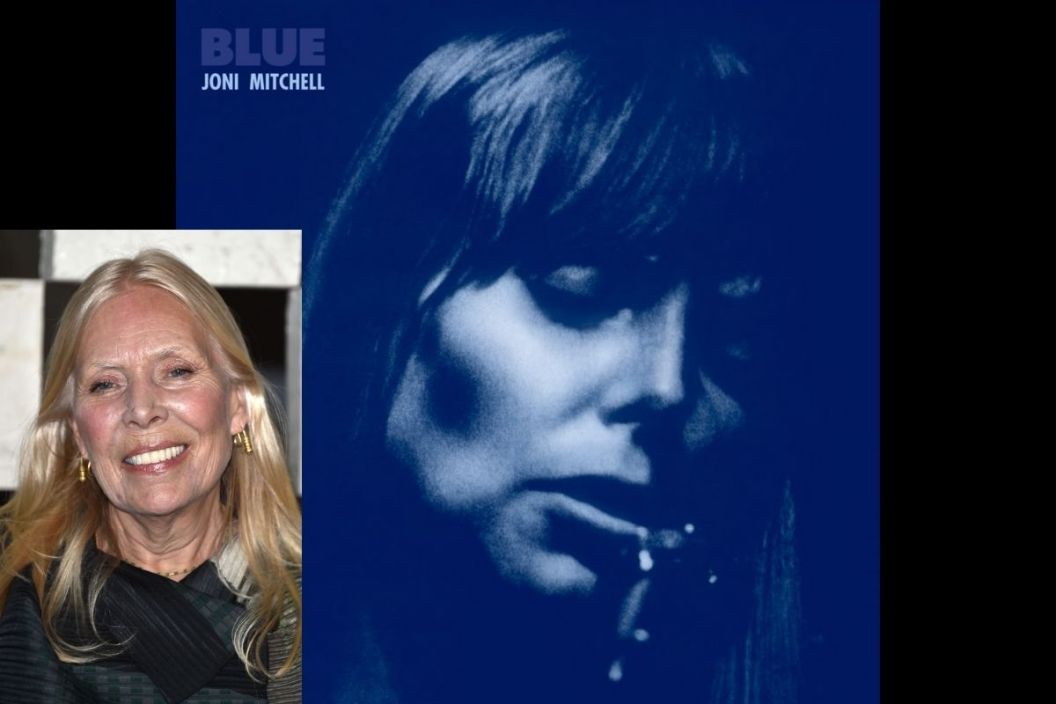Joni Mitchell's Blue is widely regarded as one of the greatest albums of all time. (To name just a few rankings: #3 on the Rolling Stone's "500 Greatest Albums of All Time," the #1 greatest album ever made by a woman according to NPR, one of The New York Times' 25 albums which represented "turning points and pinnacles in 20th-century popular music.) And this week marks the album's 50th anniversary; Blue was released on June 22, 1971. In an era fueled by rock 'n' roll, the album's slim accompaniment -- a guitar, a piano, an Appalachian dulcimer -- combined with the young songstress's raw vocals made for a surprising folk phenomenon. One that still persists today.
Videos by Wide Open Country
Over the past half-century, a lot has been written about Blue. Deservedly so. And in honor of the historic musical milestone, we've compiled various interview highlights, anecdotes, and musings pertaining to the storied album. Enjoy below.
The Early Years of Joni Mitchell
Joni Mitchell was born Roberta Joan Anderson on November 7, 1943, in Alberta, Canada. She was raised in Saskatoon. Throughout her life there, Mitchell struggled academically and preferred more creative outlets. She danced, wrote poems, painted, and as a teenager, took a particular interest in country music. After dropping out of art school, the budding singer-songwriter traveled around Canadian cities playing small gigs. But failing to make much money, Mitchell struggled and did not take naturally to the local folk scenes. Singers were possessive over their signature songs, she's described, and that attitude is what first first prompted Mitchell to write her own.
In the mid-sixties, Mitchell migrated to America where she quickly forged connections and made a name for herself with popular tracks like "Big Yellow Taxi," "Woodstock." She married fellow folk singer Chuck Mitchell in 1965, though the couple divorced just two years later. It was then that Mitchell went out to New York City to forge a solo career and embark on the tumultuous romances that would inspire her 1967 masterpiece Blue.
Making 'Blue'
During an illuminating Rolling Stone interview with Cameron Crowe back in 1979, Mitchell said of Blue:
"At that period in my life, I had no personal defenses. I felt like a cellophane wrapper on a pack of cigarettes. I felt like I had absolutely no secrets from the world and I couldn't pretend in my life to be strong. Or to be happy."
That distinct quote, the image of Saran-wrapped cigarettes, gets at the marked fragility of Blue's lyrics. (Mitchell has also reiterated this sentiment, speaking to Crowe again, describing a dream where "I'm a clear cellophane bag of exposed human organs. Just a bag of human organs with a heart beating in the center.") Mitchell first penned them while traveling around Europe in the spring of 1970. She'd embarked on the cross-continental journey while questioning her relationship with the musician Graham Nash; Mitchell eventually dumped him via telegram and the drawn-our experience is said to have inspired the tracks "My Old Man" and "River."
Read More: Lena Stone's Charming Cover of Joni Mitchell's Unconventional Christmas Classic, "River"
After returning to the States, Mitchell struck up a relationship with the legendary guitarist James Taylor. Their time together was passionate and fraught; Taylor was struggling with a heroin addiction and experiencing unprecedented fame in his own career. The song "This Flight Tonight" refers to a particular moment after Mitchell left, to catch a plane, while Taylor was questioning their affair. Despite Taylor breaking things off with Mitchell that year, he played on four tracks of Blue: "A Case of You," "Carey," "California," and "All I Want." Recently in The New York Times, Taylor spoke technically of the collaborative experience:
"Those were songs that Joni had written while she was traveling the previous year, and she wrote most on an instrument called a three-string dulcimer, which is a very mobile and very simple instrument. But it left me a wide-open opportunity to pick whatever chords would work with the melody and her spare accompaniment on the dulcimer. That was great fun for me... It's a minimal kind of accompaniment that you want, just to give you a sense of the song, harmonically, and then you can really focus on her voice and her attitude and all of those things that make this such a great Joni Mitchell album."
Not exactly the juicy personal drama we want to hear about, but interesting nonetheless. What sticks out across Blue, certainly, is the crystal clarity of Mitchell's singular soprano.
"Carey"
One of the most recognizable breakouts hits off Blue is "Carey." The friendly lyrics dance around the story of Mitchell's meeting an American in Crete. In real life, his name was Cary Raditz. Mitchell had been visiting Greece with a friend on her now-fabled 1970 sabbatical when she crossed paths with Raditz, who was a cook at the local Mermaid Cafe. And as the chorus implies, Raditz really did use a cane. And he was grumpy too! ("A mean old daddy.")
In "Carey," Mitchell uses their budding vacation friendship as an entry point to deeper themes: distraction, tourist joy, and inevitable homesickness. It's the ultimate traveler's ode in the sense that when setting out, one is often too wrapped in memories from back home.
Fun fact: "California" also makes reference to Cary Raditz as the "red, red rogue."
"Little Green"
Easily the most devastating song on Blue, "Little Green" quite directly translates a personal experience from Mitchell's early life: one which was not publicized until tabloids broke the story in 1993. At the age of 21, Mitchell was impregnated by her then-boyfriend Brad MacMath while living in Calgary. Destitute at the time, Mitchell later wrote:
"My daughter's father left me three months pregnant in an attic room with no money and winter coming on and only a fireplace for heat. The spindles of the banister were gap-toothed- fuel for last winter's occupants."
In February of 1965, Mitchell gave birth to the baby: a girl named Kelly Dale Anderson, and put her up for adoption. "Little Green" captures the wondrous hope of that choice, undercut by the obvious pain of not knowing the future for her so-called little green. The truth behind the song was confirmed in 1993 after Mitchell's old acquaintance sold the salacious story to a magazine. And four years later, the birth mother and daughter were reunited. Mitchell met her grown girl, renamed Kilauren Gibb, in 1997. Since that fateful reunion, Mitchell has remarked that she lost interest in songwriting.
That Cerulean Cover Art
The thoughtful, and at times mournful, mood of Blue is crystallized in this iconic album cover. When Joni Mitchell comes to mind, likely, it's this cool-hued photograph that follows: the singer, solo, tilts her head toward the microphone in a confessional manner. The photo, taken by Tim Considine, is straightforward, a bit melodramatic, and utterly unforgettable.
"Some Notes on Attunement"
"And then there she was, suddenly: a piercing sound, a sort of wailing -- a white woman wailing, picking out notes in a non-sequence. Out of tune -- or out of anything I understood at the time as 'tune.' I picked up the CD cover and frowned at it: a skinny blonde with heavy bangs, covered in blue."
That's how the British writer Zadie Smith describes first hearing Joni Mitchell in her enlightening (and delightful) essay "Some Notes on Attunement." The piece charts a young woman's increasingly complicated and increasingly loving relationship with the singer's work, specifically Blue. first published in The New Yorker in 2012, "Some Notes on Attunement" also appears in Smith's comprehensive 2018 collection Feel Free. Read it in full, for free, here.
Joni Jams
In honor of the Blue 50th Anniversary, the Los Angeles Times published "Joni Mitchell opens up to Cameron Crowe about singing again, lost loves and 50 years of 'Blue.' " The special piece of music news by veteran journalist Crowe -- who first interviewed Mitchell in 1979 -- celebrates the legacy of Blue through exploring the singer-songwriter's continued collaboration with various high-profile friends. The informal get-togethers include Eric Andersen, Elton John Chaka Kahn intermixed more contemporary talents Brandi Carlile and even Harry Styles. The musicians unite at Mitchell's Bel-Air home where they, simply put, jam.
Since suffering a brain aneurysm in 2015, Mitchell struggled to walk and talk -- let alone sing. And though she's regained most physical ability by now, she still does not like to sing. ("Oh, that's gone," Mitchell comments bluntly in the piece.) Still, Crowe notes, she occasionally does lend her singular voice -- momentarily -- to these jam sessions. And when she does, it's a wonder.
New Releases

[buy_now link=amzn.to/3xDzcd5]
Products featured on Wide Open Country are independently selected by our editors. However, when you buy something through our links, we may earn a commission.




